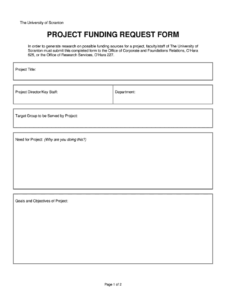Utilizing a standardized format facilitates clear communication between marketing teams and stakeholders, simplifies the approval process, and promotes accountability by establishing a clear link between planned activities and allocated resources. A well-defined structure enables more accurate forecasting, efficient resource allocation, and better control over marketing spending, ultimately contributing to improved return on investment.
This foundational understanding of structured budget requests informs the following discussion on developing effective strategies for creating and presenting these crucial documents. Subsequent sections will delve into best practices for outlining campaign goals, justifying expenses, and securing necessary approvals.
Key Components of a Marketing Budget Request
Effective budget requests require specific elements to ensure clarity and facilitate approval. The following components contribute to a comprehensive and persuasive document.
1. Executive Summary: A concise overview of the proposed marketing plan, highlighting key objectives, target audience, and anticipated return on investment.
2. Campaign Goals and Objectives: Specific, measurable, achievable, relevant, and time-bound (SMART) objectives that align with overall business goals. This section should clearly articulate what the marketing activities aim to achieve.
3. Target Audience: A detailed description of the intended audience, including demographics, psychographics, and online behavior. Understanding the target audience informs strategic channel selection and messaging.
4. Marketing Channels and Strategies: A breakdown of the chosen marketing channels (e.g., social media, email, paid advertising) and the specific strategies to be employed within each channel. This section should explain how each channel contributes to achieving the stated objectives.
5. Budget Breakdown: A detailed allocation of funds across different marketing activities, including personnel costs, advertising spend, software subscriptions, and other relevant expenses. Clear cost categorization ensures transparency and facilitates efficient resource allocation.
6. Key Performance Indicators (KPIs): Specific metrics used to measure the success of the marketing campaigns. These KPIs should be directly tied to the stated objectives and provide quantifiable data for performance evaluation.
7. Timeline: A clear timeline outlining the planned execution of marketing activities, including key milestones and deadlines. This provides a roadmap for implementation and facilitates progress tracking.
8. Contingency Plan: A brief outline of potential challenges and alternative strategies to mitigate risks and adapt to unforeseen circumstances.
A well-structured request, incorporating these components, provides stakeholders with the necessary information to assess the value and feasibility of the proposed marketing plan, ultimately increasing the likelihood of approval and contributing to campaign success.
How to Create a Marketing Budget Request Template
Developing a standardized template streamlines the budget request process and ensures consistency across marketing initiatives. The following steps outline a structured approach to template creation.
1. Define Scope and Objectives: Establish the template’s purpose and the types of marketing activities it will encompass. Clearly define the information required for each budget request.
2. Structure the Template: Create distinct sections for each key component, including an executive summary, campaign goals, target audience, marketing channels, budget breakdown, key performance indicators (KPIs), timeline, and contingency plan.
3. Develop Input Fields: Provide clear instructions and pre-formatted fields for each section, ensuring consistency in data entry and facilitating data analysis. Utilize dropdown menus, checkboxes, and other interactive elements to streamline the process.
4. Incorporate Formulas and Calculations: Automate calculations for totals, percentages, and other key metrics within the template. This minimizes manual data entry and reduces the risk of errors.
5. Design for Visual Clarity: Employ clear headings, subheadings, and formatting to enhance readability and navigation. Visual consistency improves comprehension and facilitates efficient review.
6. Establish Version Control: Implement a version control system to track changes and maintain an accurate record of template revisions. This ensures clarity and avoids confusion when working with multiple iterations.
7. Test and Refine: Pilot the template with various marketing teams and gather feedback to identify areas for improvement. Regularly review and update the template to reflect evolving business needs and best practices.
A well-designed template provides a framework for clear communication, accurate forecasting, and effective resource allocation, ultimately supporting successful marketing initiatives.
Standardized documents for requesting marketing funds provide a crucial framework for planning, justifying, and executing marketing strategies. These structured formats facilitate clear communication between marketing teams and stakeholders, enabling efficient resource allocation and performance measurement. Key components such as clearly defined objectives, target audience analysis, channel strategies, and budget breakdowns ensure comprehensive proposals. Implementing a standardized template promotes consistency, simplifies the approval process, and fosters accountability, ultimately contributing to improved return on investment and overall marketing effectiveness.
Effective resource management remains essential for successful marketing initiatives. Organizations that prioritize the development and implementation of robust budget request processes are better positioned to achieve their marketing objectives and drive business growth. Continued refinement of these processes, informed by data analysis and industry best practices, will remain critical for maximizing marketing ROI in an increasingly competitive landscape.
